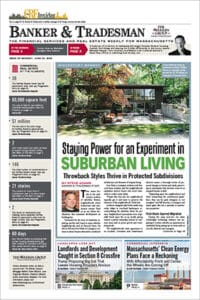Jane Kepros
Director of Lab Programming, Margulies Perruzzi
Age: 44
Industry experience: 22 years
Eight years of hands-on experience in the life science world was the foundation of Jane Kepros’ career switch, where she now plays a role in shaping the next generation of research facilities. The former biologist jumped at the chance to pursue her childhood dream profession in architecture, making the full-time move in 2011 to lab planning and participating in more than 130 projects in the past 12 years. In June, Kepros joined Boston-based Margulies Perruzzi as its new director of lab programming. In the new role, Kepros is responsible for design of labs, specialty suites, manufacturing facilities and support space for the local biopharma sector.
Q: What prompted your decision to make a career transition from life science to architecture?
A: When I was a child, I wanted to be an architect when I grew up. That changed to biomedical engineering and that’s what I got my degree in. I ended up working in labs. When I was in my mid-20s, I was thinking about going back to school for architecture and looking for a change, and I didn’t want to commit the time and money without knowing it was going to be something I liked doing in the long run. I took a few classes at the Boston Architectural College just for fun, to decide if I liked the design side of things, and started looking for a role as an administrator. Serendipitously, I found an ad for a lab planner for a small boutique firm that was looking for someone with 10-plus years’ experience: no architectural experience needed, but someone who was open to learning from the architectural side. I fell into it in 2011, and it was a role that I didn’t know existed.
Q: What are the major differences in workplace culture between life science and architecture?
A: I was really nervous when I started in architecture because I had never worked in an office before. I’d worked in hospitals and labs and had no experience sitting at a desk, especially in an open office concept where there were folks around me on phone calls. That was a big culture shock, coming in and sitting at a computer every day.
Q: How does your own experience in life science inform your approach to lab planning from an employee’s perspective?
A: I can’t describe how valuable it is that I have the experience working in a lab. I’ve worked with so many lab planners at different offices who have lab background, but not an architecture background, and I’m constantly finding things I’m seeing in passing and during a meeting, and it’s totally new to them. There’s so much I take for granted: just having an understanding of workflows, how groups work together. Having worked at small startups, and even getting to see how even non-lab groups such as regulatory and legal and finance and how they interact with the lab folks, and how the workflows from one department to another, can impact how you want to group different user groups or departments within a building. It doesn’t always have to be a lab group with a lab group, and that gets overlooked.
Q: What are some of the important considerations designing incubator space, which has seen an uptick in interest among developers reflecting the smaller leasing requirements?
A: The layouts aren’t that different in terms of space planning. The biggest challenge is figuring out the utilities. The less you know ideally, the more you would distribute different types of utilities to allow for flexibility in the future to allow for different types of experiments or processes. Ideally, you would have everything everywhere, but there’s an expense for that.
Q: Given the current surplus of lab space in Greater Boston, what other uses can be suitable for adaptive reuse?
A: Weirdly, there are still folks reaching out to us to build out more spec lab space. There is a lot of talk about new tech and industrial type projects, and I do see some tenants looking at [lab] space to see if it will work for them depending upon how it was built out. We are having conversations and people are working out the due diligence to see if it works for tough tech. Some of those sectors are getting more VC money and looking to expand, and there is a shortage of space that is built for them. Rather than office conversions, they are looking at lab space as a better potential fit for them.
Q: How are changes in industry research processes influencing the life cycle of lab design and how frequently the standards are changing?
A: A lot of things are getting smaller scale, so where maybe you were doing larger processes with larger equipment and fume hoods and bigger volumes, you can do on a much smaller bench-top scale now. I think it lends itself better to flexibility. We used to see a lot more walled-off areas in lab design, where you would have separate areas for each function. Mobile casework used to be rare, and now that’s the standard for commercial labs. It means the space doesn’t need to be redesigned as frequently.
Q: Are you seeing interest in the new hybrid lab-industrial zoning that Boston has been studying for areas such as the South Boston marine park and Newmarket, and how can those uses efficiently coexist?
A: Pretty much anything can go close to labs. People get worried about what’s in the lab: is there going to be an explosion, is there the next COVID-19 coming out of a lab? To be honest, if the space is properly designed, it’s not any more risky than any other type of space. Even restaurants have commercial kitchens and chemicals on-site, and breweries and bakeries have explosion risks. If it’s designed right, there’s no reason why you can’t have retail, residential and industrial types under the same roof.
Kepros’ Five Favorite Halloween Costumes:
- Peacock
- Airplane
- Spider
- Lobster
- Goldfish





